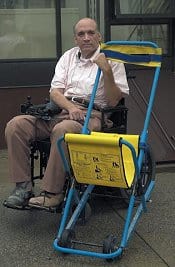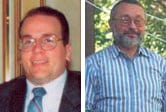By Josie Byzek and Tim Gilmer
Here are the stories of two men, Ed Beyea and John Abruzzo–both wheelchair users–who were working on separate floors of the World Trade Center on Sept. 11, 2001. True to the human drama of that day, one lived and one died, but their stories stand as a tribute to the friends and coworkers who risked their lives to help them.

Ed Beyea, 42, had just celebrated the 20th anniversary of his diving accident. Many of us do it–look back and celebrate how far we’ve come. Beyea, a C3 quad, had logged 14 years at Blue Cross/Blue Shield since his injury and was now a high-level program analyst working on the 27th floor of One World Trade Center.
Abe Zelmanowitz, 55, also a programmer, had joined the office two years after Beyea was hired. He was the kind of person who always sought a common bond with people. The two became fast friends. “They were very, very close, sharing their love of music and books, trading back and forth,” says Abe’s sister-in-law, Evelyn. Abe, a single man, lived in the basement of his brother Jack and Evelyn’s home. On the Sabbath he would walk from one end of Brooklyn to the other to check on his elderly father. After his father died at 94, his mother moved in with the rest of the family.
Beyea had found his niche in society and enjoyed the company of close friends. Following his accident, he had attended a computer skills program for people with disabilities in Manhattan. Big corporations like Blue Cross/Blue Shield were interested in hiring graduates of the program.
Often, after work, the two would hang out at Beyea’s apartment. Irma, 68, Beyea’s daytime aide, would be with them. Beyea, says Irma, loved a good Cuban cigar. “He knew how to enjoy life. He was in pain every day, but he never took more than one Tylenol. He didn’t dwell on the pain.” Zelmanowitz rigged up a custom cigar holder for his friend. “Ed would reach down to the holder and pick up the cigar in his mouth very gently,” Irma says. “He was a happy man, smiling and telling jokes.”
Sometimes the two would meet after work with Manny, another friend, and go get a beer. Every three months the four of them–Ed, Abe, Manny and Irma–would go out to dinner. The men would take turns picking up the tab, never skimping. On these special occasions, says Irma, “they ate only the best, always at a kosher restaurant. Whatever they wanted, they got.”
* * *
John Abruzzo, a staff accountant for the Port Authority of New York and New Jersey, was working at his computer on the 69th floor of One World Trade Center when the first hijacked jet sliced into the tower. “It felt like the building was punched,” he says. “My desk faces north … the side the airplane hit. Paper was just coming down.” Worse, the building swayed–and only in one direction.
By the time Abruzzo, a C5-6 quad, had maneuvered his power chair into the hallway, he saw only 10 of his coworkers–everyone else had already evacuated. Someone found the office EVAC+ CHAIR and transferred Abruzzo out of his new, customized Arrow into the rescue device, which resembles a large, folding baby stroller with rear wheels that pop up and a sled-like component that takes their place when going down stairs.
Nine of his 10 coworkers worked in shifts of three to four, carefully lowering Abruzzo down each flight of stairs. One of them couldn’t help physically, so he scouted ahead. When he returned, he warned of heavy smoke around the 40th floor, so the group, with Abruzzo in tow, cut across to a stairwell on the other side of the building.
* * *
Irma was in the bathroom by the cafeteria on the 43rd floor when she heard a boom and felt the building shaking. She thought it was an earthquake. By the time she and others had made their way out of the bathroom, water and debris covered the floor. “People just dropped their food on the floor and took off,” she says. Smoke had already made its way to the cafeteria. She went down the north stairwell to the 27th floor and crossed over to the south side to find Beyea.
Zelmanowitz had just arrived at Beyea’s side when a man approached and asked, “Can I help? Can I take you down the stairs?”
Beyea said no, he would wait. He was a big man–nearly 300 pounds, very difficult to lift. Irma knew he wanted to be carried properly so he wouldn’t break any bones, which had happened before. “He needed more than one man to carry him,” she says. “He needed at least two or three firemen. And knowing him, he wanted others to go first. He didn’t want to be in the way. None of us were thinking then that the building might collapse.”
Zelmanowitz volunteered to stay with Beyea, suggesting Irma leave because she was coughing. When she reached the lobby she found a fireman and told him where Beyea was. “Please take care of him,” she pleaded. “He needs oxygen.” Usually he required oxygen only when sleeping at night, but conditions were severe. The fireman said he would find him. A chain of men directed people outside. Irma got caught up in the crowd of people evacuating the building.
Back on the 27th floor, Zelmanowitz was talking on his cell phone, telling his family he was OK. His elderly mother pleaded with him to get out, but he was determined to stay by Beyea’s side. He would wait with his best friend of more than 12 years.
* * *
Somewhere near the 30th floor, the crew of coworkers carrying Abruzzo had to move aside as firefighters rushed up the stairwell. “We saw them carrying hundreds of pounds of equipment–axes, hoses–and they were trying to catch their breath, they were exhausted,” Abruzzo says.
At the 20th floor they heard a rumble that seemed to come from the other tower–steel and concrete collapsing. At the 10th floor they heard another rumble but kept going. “Nothing was going to stop us.” Finally they made it to the lobby, where Abruzzo had to be carried over chunks of fallen concrete. Damage and debris had made the exit impassable. Firefighters directed Abruzzo’s helpers to lift him–still in the EVAC+CHAIR–through a knocked-out window and out onto the sidewalk.
They looked up and saw fire engulfing the top of the tower. “We thought we were fine now, we were out, but a fireman said, ‘Get out, GET OUT!'” They squeezed into the mob streaming up the streets away from Lower Manhattan, taking turns pushing Abruzzo, still in the rescue device. At one point the group stopped to look back. “It was like Christmas, everything covered in white. Except we saw debris coming down,” says Abruzzo, “and bodies falling.”
They didn’t look back again until they reached the corner of Vesey and West. “We couldn’t see the tower I was in, but that’s when it came down. There was a cloud of debris chasing the firemen and policemen. One of the firemen grabbed my chair, carried me into Stuyvesant High School, and then everything just went black.”
Once the blackness lifted, an ambulance took Abruzzo to a hospital for smoke inhalation. Gone was his new power wheelchair, left on the 69th floor. His van, parked three blocks away, was never found.
* * *

In his address on the national day of prayer and remembrance, President Bush recognized the sacrificial devotion of Abe Zelmanowitz, saying, “One man who could have saved himself stayed until the end at the side of his quadriplegic friend.” Soon the story spread around the world and returned to the Zelmanowitz family. “To find such goodness in the midst of evil,” offered a man calling from Australia, “is like a ray of hope for humanity.”
“His actions of that day were his actions of every day,” says Esther Zelmanowitz, the wife of Abe’s nephew. “He was an Orthodox Jew who read his Bible, attended synagogue regularly and treated his friends the same regardless of religious or other differences.” Beyea was a Christian.
* * *
John Abruzzo still has the EVAC+CHAIR. “That chair and those 10 people saved my life,” he says.
Abruzzo’s heroic coworkers all survived: Michael Ambrosio, Peter Bitwinski, Philip Caffrey, Richard Capriotti, Michael Curci, Michael Fabiano, Wilson Pacheco, Anthony Pecora, Gerald Simpkins, and Peggy Zoch.
“I’ve been working at the Port Authority for 19 years and I’ve known most of them for that entire time,” Abruzzo says. He knows their spouses, watched their children grow up. “They had an awful lot to lose. I don’t know what to say. Thanks? That’s not enough for what they did. It’s unbelievable.”
Support New MobilityWait! Before you wander off to other parts of the internet, please consider supporting New Mobility. For more than three decades, New Mobility has published groundbreaking content for active wheelchair users. We share practical advice from wheelchair users across the country, review life-changing technology and demand equity in healthcare, travel and all facets of life. But none of this is cheap, easy or profitable. Your support helps us give wheelchair users the resources to build a fulfilling life. |


Good decent man